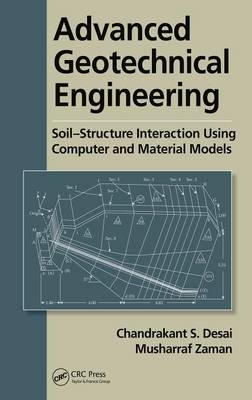
Advanced Geotechnical Engineering
Crc Press Inc (Verlag)
978-1-4665-1560-4 (ISBN)
This book presents finite element (FE), finite difference (FD), and analytical methods and their applications by using computers, in conjunction with the use of appropriate constitutive models; they can provide realistic solutions for soil–structure problems. A part of this book is devoted to solving practical problems using hand calculations in addition to the use of computer methods. The book also introduces commercial computer codes as well as computer codes developed by the authors.
Uses simplified constitutive models such as linear and nonlinear elastic for resistance-displacement response in 1-D problems
Uses advanced constitutive models such as elasticplastic, continued yield plasticity and DSC for microstructural changes leading to microcracking, failure and liquefaction
Delves into the FE and FD methods for problems that are idealized as two-dimensional (2-D) and three-dimensional (3-D)
Covers the application for 3-D FE methods and an approximate procedure called multicomponent methods
Includes the application to a number of problems such as dams , slopes, piles, retaining (reinforced earth) structures, tunnels, pavements, seepage, consolidation, involving field measurements, shake table, and centrifuge tests
Discusses the effect of interface response on the behavior of geotechnical systems and liquefaction (considered as a microstructural instability)
This text is useful to practitioners, students, teachers, and researchers who have backgrounds in geotechnical, structural engineering, and basic mechanics courses.
Chandrakant S. Desai is a regents’ professor (emeritus), Department of Civil Engineering and Engineering Mechanics, University of Arizona, Tucson Dr. Desai is recognized internationally for his significant and outstanding contributions in research, teaching, applications, and professional work in a wide range of topics in engineering. Dr. Desai has authored/coauthored/edited 22 books in the areas of finite element method and constitutive modeling, and 19 book chapters, and has authored/coauthored about 320 technical papers in refereed journals and conferences. He has served on the editorial boards of 14 journals, and has been the chair/member of a number of committees of various national and international societies and conferences. He has been the founding President of the International Association of Computer Methods and Advances in Geomechanics, and founding Editor-in-Chief of the International Journal of Geomechanics (IJOG) published by the American Society of Civil Engineers. Musharraf Zaman holds the David Ross Boyd Professorship and Aaron Alexander Professorship in Civil Engineering at the University of Oklahoma (OU), Norman. He is also an alumni chair professor in Petroleum Engineering. He has been serving as the associate dean for research in the OU College of Engineering since July 2005. Zaman received his baccalaureate degree from the Bangladesh University of Engineering and Technology, and his PhD degree from the University of Arizona, Tucson. He has published 158 journal and 215 peer reviewed conference proceedings papers, and eight book chapters. He also serves as the editor-in-chief of the International Journal of Geomechanics, ASCE.
Introduction
Importance of Interaction
Importance of Material Behavior
Ranges of Applicability of Models
Computer Methods
Fluid Flow
Scope and Contents
References
Beam-Columns, Piles, and Walls: One-Dimensional SimulationIntroduction
Beams with Spring Soil Model
Laterally Loaded (One-Dimensional) Pile
Numerical Solutions
Finite Element Method: One-Dimensional Simulation
Soil Behavior: Resistance–Displacement ( py –v or p–y) Representation
One-Dimensional Simulation of Retaining Structures
Axially Loaded Piles
Torsional Load on Piles
Examples
Problems
References
Two- and Three-Dimensional Finite Element Static Formulations and Two-Dimensional ApplicationsIntroduction
Finite Element Formulations
Nonlinear Behavior
Sequential Construction
Examples
Problems
References
Three-Dimensional ApplicationsIntroduction
Multicomponent Procedure
Examples
Problems
References
Flow through Porous Media: SeepageIntroduction
Governing Differential Equation
Numerical Methods
Finite Element Method
Invariant Mesh or Fixed Domain Methods
Applications: Invariant Mesh Using RFP
Problems
Appendix A
References
Flow through Porous Deformable Media: One-Dimensional ConsolidationIntroduction
One-Dimensional Consolidation
Nonlinear Stress–Strain Behavior
Numerical Methods
Examples
References
Coupled Flow through Porous Media: Dynamics and ConsolidationIntroduction
Governing Differential Equations
Dynamic Equations of Equilibrium
Finite Element Formulation
Special Cases: Consolidation and Dynamics-Dry Problem
Applications
References
Appendix 1: Constitutive Models, Parameters and Determination s
Appendix 2: Computer Software and Codes
Index
| Zusatzinfo | 68 Tables, black and white; 495 Illustrations, black and white |
|---|---|
| Verlagsort | Bosa Roca |
| Sprache | englisch |
| Maße | 156 x 234 mm |
| Gewicht | 1020 g |
| Themenwelt | Naturwissenschaften ► Geowissenschaften ► Geologie |
| Technik ► Bauwesen | |
| Technik ► Bergbau | |
| Technik ► Umwelttechnik / Biotechnologie | |
| Weitere Fachgebiete ► Land- / Forstwirtschaft / Fischerei | |
| ISBN-10 | 1-4665-1560-0 / 1466515600 |
| ISBN-13 | 978-1-4665-1560-4 / 9781466515604 |
| Zustand | Neuware |
| Haben Sie eine Frage zum Produkt? |
aus dem Bereich


